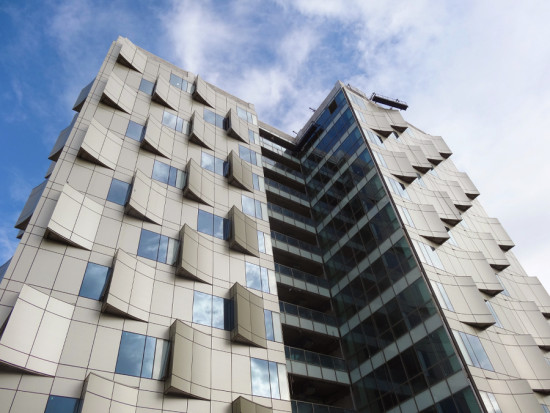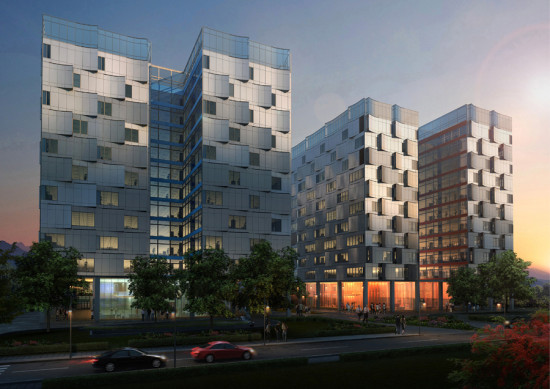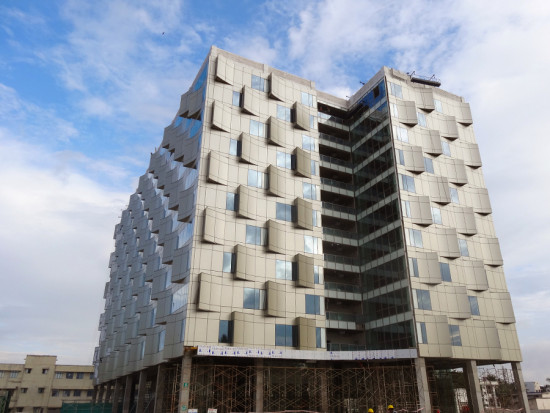
Modular self-shading system delivers budget-friendly environmental performance.
Tapped to design the facade for the HUB-1 office building at Karle Town Centre in Bangalore, India, New York–based Merge Studio faced a two-pronged challenge: crafting an efficient envelope that would beat the heat without breaking the developer’s budget. Moreover, the architects (whose role later expanded to include landscape and public space design) aspired to lend the twelve-story tower, the first in the 3.6 million-square-foot SEZ development, an iconic appearance. “The idea was that we bring together the aesthetics of the facade and make it performative as well,” explained Merge founder and advisor Varun Kohli. Despite financial constraints dictated by India’s competitive development market, Merge delivered, designing a modular facade comprising metal and glass “waves” that cut solar gain while allowing light and air to penetrate the interior.

Solar analysis helped dictate Merge’s overall strategy for the building envelope. “In this climate, the maximum impact in terms of heat loads happens through direct radiation, as opposed to conductive heat transfers, which meant that the shading aspect was most important,” said Kohli. To lower costs, the architects came up with the idea of a modular, self-shading system in which successive “waves,” oriented vertically, shade adjacent glazing. They also streamlined construction through a combination of a minimal material palette and off-site prefabrication. Though Merge had to special-order 1.5-meter Alubond panels, “everything else was fairly simple,” said Kohli. “We made sure that there’s no glazing where the aluminum panels curve.” Mumbai’s SP Fab manufactured and installed the facade, splitting each “wave” into three prefabricated pieces that were then trucked to the site and hooked on.

- Facade Manufacturer
SP Fab - Architects
Merge Studio - Facade Installer
SP Fab - Facade Consultant
Environmental Design Solutions (New Delhi, sustainability consultant) - Location
Bangalore, India - Date of Completion
2015 - System
prefabricated modules comprising curved aluminum composite panels and high performance glazing - Products
Alubond aluminum composite panels, St. Gobain India glazing
HUB-1’s glazing was carefully plotted according to the solar studies, with windows decreasing in size on the tower’s upper levels. The architects also reduced the window-to-wall ratio on the east- and west-facing sides of the building. They selected double-glazed windows with a low-e coating from St. Gobain India. “It’s one of the few buildings using the most high performance glass available in the country,” noted Kohli. “It was a careful selection of [performance] strategies.” Ventilation is provided by operable vertical slot windows between the crest of each “wave” and the adjacent panel. “Studies showed that we would be able to grab more air through those because of turbulence as it moves around the surface,” said Kohli.
Some of Merge’s initial hopes for improved environmental performance were quashed by the financial reality on the ground. “Obviously, we made a number of compromises along the way,” said Kohli. “But I think we can still prove that we were able to save energy in the range of 15-16 percent due to the facade alone.” The building as a whole, which will be complete this spring, is targeting LEED Gold certification. Kohli also noted the self-shading system’s potential, given a different set of circumstances. “When we first started developing this, we had enough variables that we could really manipulate the facade in response to the environment; the curves could be larger or smaller, and other variables,” said Kohli. “But given the fact that we’re designing in a market that’s very tough financially, we had to really dumb it down. There’s quite a bit of [room to explore].”





